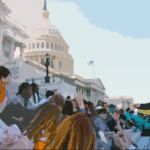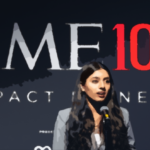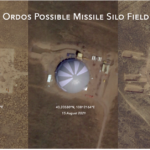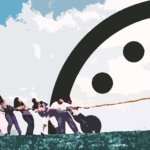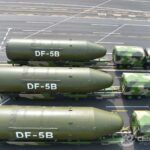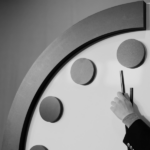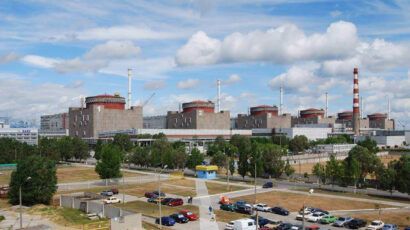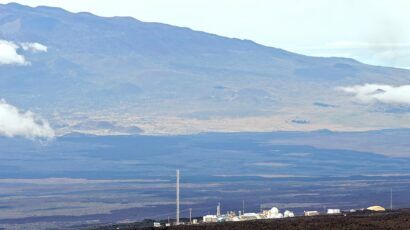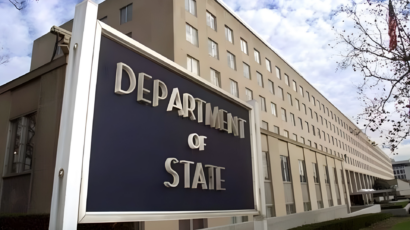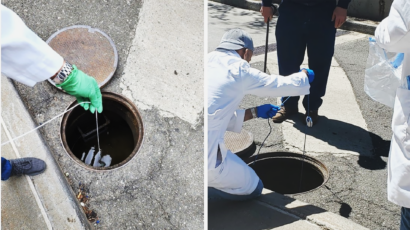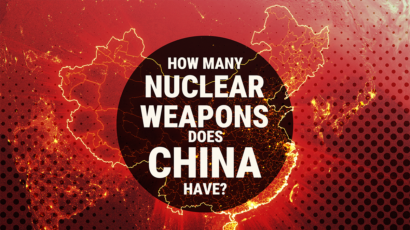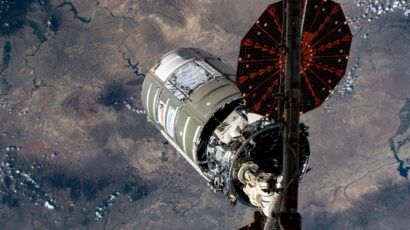How my Gen Z students learned to start worrying and dismantle the Bomb
By Frida Berrigan | January 15, 2024
How my Gen Z students learned to start worrying and dismantle the Bomb
By Frida Berrigan | January 15, 2024
I dropped the Bomb on my students (figuratively, of course). The mushroom cloud expanded out from the center of New London, our small Connecticut town of 27,000.
The 300-kiloton weapon vaporized City Hall, the Public Library and our beautifully renovated courthouse, originally built in 1784. The Episcopal, Catholic, Baptist, First and Second Congregational churches were all reduced to ash. The brick house of worship built by Unitarians in 1909—where the Haitian Seventh Day Adventist congregation now gathers—disappeared in that same instant.
Urban renewal’s malls and highways emptied our downtown 30 or 40 years ago; the bomb blast wave flattened the remaining historic buildings. Our harbor—once a port for whaling and slaving ships and now home to a windmill assembly pier, many ferries, and the construction site for a new Coast Guard Museum—was reduced to a steaming pile.
Right inside the edge of the fireball line was my home, where my three children and husband and I live. Inside that inner ring, almost nothing would survive.
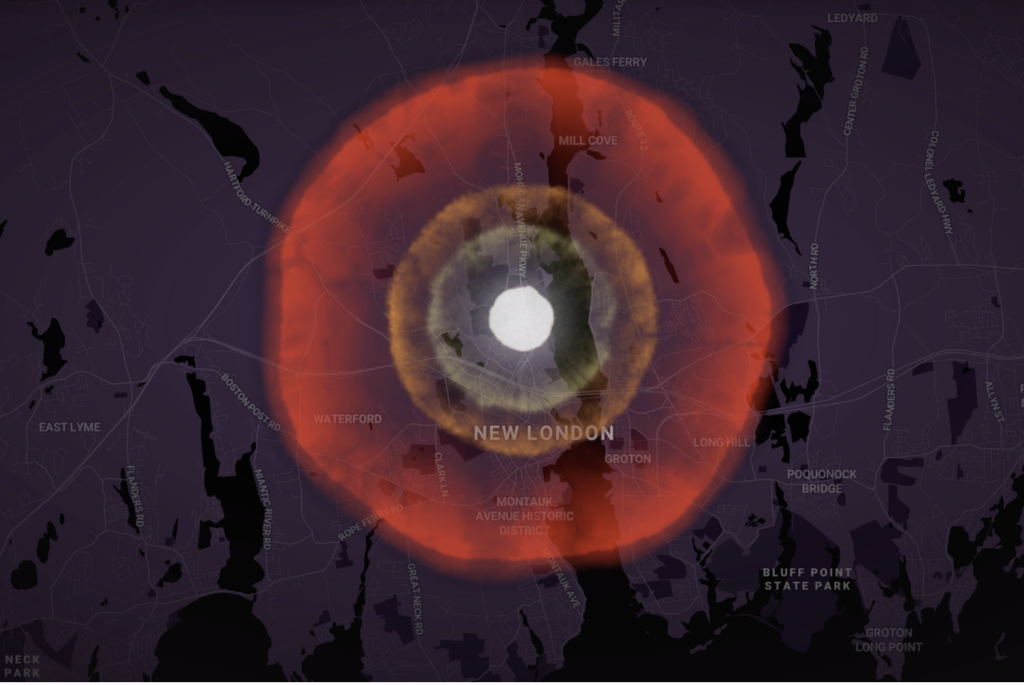
Based on Alex Wellerstein’s popular Nukemap[1], the Outrider Foundation’s “what would happen if a nuclear bomb went off here” website[2] showed Connecticut College—the small, private liberal arts campus where my students and I sat for their First Year Seminar—inside the wider shockwave zone around New London. The note at the margin of the screen explained that within that zone “most residential buildings collapse, injuries are universal, fatalities are widespread.” No emotion in those words, but I looked over the faces of 18 promising young people and teared up. Another cold calculation appeared in the upper right-hand corner of the screen: 29,498 fatalities and 24,996 injuries. More than New London’s total population gone; dead, incinerated, shadows on the wall. We sat silently for a few minutes.
These poor young people! They are subjected to social media saturation, the COVID pandemic wrecked their high school experience, they face impending and present climate catastrophe, mountains of debt, the new challenge of Chat GPT and accessible AI invading their brains and eroding their trust. They have to contend with nuclear dangers too?
I wanted to wave it all away, pretend it doesn’t exist. After all, that seems to be the approach most Americans take to nuclear weapons: a healthy dose of “la, la, la.” According to one recent poll,[3] nearly 60 percent said they didn’t know enough about nuclear weapons to assess their “benefit or harm.” But waving it away isn’t what teachers do—activists neither. And I was standing in front of these 18 young people as a bit of both, teaching a course I humbly call “How to Change the World.”
Getting motivated
I am not part of the duck-and-cover generation. I was born in 1974—squarely Gen X—and came of age in the post-Cold War era. But, as the child of anti-nuclear activists, the threat posed by nuclear weapons was never far from my mind. Even knowing that I didn’t have a typical upbringing, the degree of ignorance across generations shocks me. The Gen Z kids sitting in front of me didn’t know about nuclear weapons because their teachers and their parents—mostly people my age and younger—didn’t tell them. I was here to right that wrong and bring them up to speed, but I also didn’t want to scare or scar them as I was scared and scarred as a kid. Could I motivate them to action without terrifying them first?
Some of my students were more excited to explain how I can rip Oppenheimer and watch it at home on my Roku than they were to delve more deeply into nuclear dangers. But most seemed relieved to be able to talk about the potential end of the world. In July 2023, the Carnegie Corporation of New York partnered with the Chicago Council on Global Affairs in a major survey of nuclear knowledge and attitudes across generations.[4] They found that younger Americans (like my students) are 50 percent more likely to think that nuclear weapons make the United States less safe or make no difference. Gen Z is pilloried as being afraid of making simple phone calls, but my students engaged bravely and thoughtfully on this difficult topic.
A few students had ready explanations for how and why a nuclear catastrophe would never happen here. They said things like: “the United States has learned from our past mistakes,” “there are safeguards in place,” “they are just posturing.”
Psychologists have termed this impulse “motivated denial.” When faced with the threat of existential peril, the mind invents policies or technologies or other rationales for why the worst won’t happen. My students are not alone in this exercise; it happens pretty often. Motivated denial is deployed in the face of irrefutable evidence of climate peril too. People meet the news of human-made climate catastrophe and system breakdown by imagining that technological feats of fancy will solve the crisis like personal domes, or massive sea walls to protect coastal cities, or Martian colonies.
The alternative, in facing the existential threat posed by nuclear weapons or climate change, is whole system change. In order to remove the threat of nuclear weapons, we need total disarmament; that would change so much about US society that it starts to feel overwhelming. The same with climate change: Everything would have to change to reverse or mitigate its worst effects, and build resilience into all of our systems. Whole system change seems a lot harder than just living in terror and tying ourselves in logical knots.
But I felt I had my students’ attention and their concern, and with that I could spur them to curiosity, action, and change. So I leaned into their discomfort and challenged their denial. I told them that it could, in fact, happen here. New London was surely put on a Soviet target list long ago because of the US Navy submarine base and construction facility in Groton, right across the Thames River from campus (a number of my students are rowers or sailors and see the facilities bristling with security as they float past). Since the first nuclear-armed submarine launched from its shipyards in 1959, General Dynamics’ Electric Boat division has built dozens of submarines designed to “deliver” nuclear weapon strikes all over the world with stealth and precision. In the 1970s and ’80s, as the US nuclear arsenal grew to more than 23,000 warheads, men worked around the clock, drinking their breakfasts at the local bars before heading into the yards to weld and rivet.

There are fewer welders and riveters now. General Dynamics is trying to hire thousands of engineers—software, industrial, and propulsion motor engineers—to build the next generation of submarines: the Columbia Class. The US Navy estimates that the total cost of this new set of 12 “boats” (as the 560-foot-long behemoths are called) will top out at$132 billion.[5] Throughout the armed forces, the United States plans to spend more than $1.5 trillion (a thousand billions!) over the next 30 years to modernize and upgrade nuclear weapons.[6]
“Why?!” my students demanded, thinking about all the money their futures require: college debt forgiveness (one year at Connecticut College costs $82,697, including room and board), clean energy and green technology investment, a 21st-century infrastructure—to say nothing of basics like affordable housing, health care, and even potable drinking water (not taken for granted in many parts of the richest country in the world).
I told them about the congressionally appointed group that had just released a bipartisan report on US nuclear strategy. (Yep, that is one place where Republicans and Democrats in Congress can agree: the end of the world as we know it. Bipartisan investment in the military industrial complex and fighting and winning nuclear wars!) The Congressional Commission on the Strategic Posture of the United States met for more than a year and released their findings in October.[7] They assert that the United States should be investing more in nuclear weapons so that our military can counter Russia and China—which they term “near peer” nuclear adversaries—in order to “be ready to deter and defeat” both adversaries at once.
I let that sink in. The best plan they have is to wage two new Cold Wars and prepare for two nuclear hot wars against Russia and China, together home to a fifth of the world’s population. It defies contemplation. The facsimile of destruction I presented on our classroom screen was just one bomb: a 300-kiloton warhead. The United States has 1,770 of them deployed on submarines, intercontinental ballistic missiles and bombers, and more in reserve. Russia has a comparable number of deployed warheads (1,674 at last count) and 4,489 in reserve. China keeps their nuclear arsenal a closely guarded secret, but the Nuclear Notebook (where all these figures are found) estimates they have around 410 nuclear warheads. The United Kingdom has an estimated 225 warheads and France has another 290. India does not disclose its nuclear fire power, but experts put it at roughly 160 warheads. Pakistan, its longtime rival, is estimated to have 170. North Korea is not forthcoming either, and their nuclear firepower is a mystery, but it is estimated at 20-30 warheads for medium range delivery systems. Finally, Israel practices what the nuclear arms control community calls “nuclear ambiguity” but could have a nuclear stockpile of as many as 90 warheads.[8]
This is a tinderbox waiting to blow. It makes the Cold War standoff between two nuclear armed superpowers locked in Mutually Assured Destruction look like stability—expensive and dangerous and always on the verge of conflagration, but retrospectively stable. All of this makes my little bomb drop demonstration less of a classroom exercise and more like existential preparation!
My students were outraged. That is a good thing. Nuclear weapons are once again on the top of many people’s minds, and not just because of Christopher Nolan’s Oppenheimer blockbuster. As I write this, there are conflicts raging that involve four nuclear powers. The United States is aiding Israel in its invasion and bombardment of the Gaza Territory. They are both nuclear powers. Russia is at war with Ukraine, and the United States is aiding the Ukrainian fight. And as all of that rages, China is menacing Taiwan, building military islands and rattling sabers of its own.
Ever since Russia’s February 2022 invasion of Ukraine, people have been Googling basic information about nuclear weapons. According to an analysis of Google searches by ReThink Media, Americans’ interest in “nuclear war” increased by over 1,000 percent in late February 2022.[9] That is the greatest interest in the issue in at least a decade. That interest has remained elevated, and increased again after Hamas’ October 7 attack on Israel and the nuclear-armed power’s subsequent invasion of Gaza.[10] I see those millions of Google searches as evidence of a motivated curiosity, an impulse to learn enough to construct a way out of nuclear proliferation and peril. A motivated curiosity to counter the motivated denial!
Making connections
As my students and I talked about nuclear weapons, I kept thinking about the environmental movement, and the need for a concerted, massive, Manhattan Project-level of investment and people power to work on climate change. Unlike the world’s nuclear menace, these young people did learn about climate change all through school. They were ready to engage with that. They see themselves as environmentalists—drinking out of expensive metal water bottles, complaining about how often the grounds crew mows the lawn, carefully considering which bin should receive their empty smoothie cups.
For a long time, there was a false competition between climate change and nuclear weapons. I remember hearing grumbling among some of my fellow anti-nuclear activists: “Oh, now they care about the end of the world? Why is climate change work attractive to young people while nuclear disarmament turns out the woolen socks and Birkenstock crowd?” I thought about how I was starting from scratch, introducing my students to the issue of nuclear weapons. How would they choose which movement to stand with?
D’oh! That was my Gen X binary thinking showing (how embarrassing). They do not need to choose. They just need to start!
The watchword that dissipates all this competition is intersectionality, which sounds new but has always been the hallmark of successful movements for change, from the anti-nuclear movement to the civil rights movement. The harms and dangers of deceptively abstract concerns like nuclear weapons and climate change are directly linked to the perpetuation of everyday concrete injustice that persists everywhere. These problems, and their solutions, are all connected, now more than ever.
At the Climate March in New York City in September, the Anti-Militarism Hub gathered to say that “the climate crisis is escalating—but so is the global movement for climate justice. … The US military is the world’s single largest consumer of oil and the biggest emitter of greenhouse gasses.” There was joy and possibility there—that is what drew 75,000 people to a march and rally calling for an end to killing the planet. At the march, Representative Jamaal Bowman, (D-NY) told the activists, “It has to be the craziest thing in the world that the US government actually subsidizes its own self-destruction. … [W]e continue to give almost a trillion dollars a year to our military-industrial complex, which is the number one contributor to carbon emissions in the world.”[11] When you put it that way, Congressman Bowman, it really does sound insane!
The anti-nuclear movement modeled an intersectional approach early on. It built relationships with First Nations upon whose land—and against whose sovereignty—the raw materials for the nuclear chain reaction were mined and the atomic bomb tests were sited. It nurtured second and third wave feminists, developed consensus-based decision making, and refined affinity group action structures that allowed for flexible, responsive and empowered horizontalism even under difficult circumstances. The intersections between anti-nuclear and anti-racism work go back to the beginning, with the great Black intellectual W.E.B. DuBois pointing out the United States’ racism in dropping the bomb on Hiroshima and working tirelessly for the Ban the Bomb petition.
My students didn’t seem to need this part of the lesson. As Gen Z, they tend to understand these overlapping forms of injustice even without all the details. The Black Lives Matter movement, for instance, has engaged even the most privileged students to think more critically about race and policing. My students aren’t all rallying to Defund the Police, but they can all agree that body cameras, civilian oversight, and fewer weapons will mean less police violence against Black people. I nudged them to extend their skepticism: If we don’t trust an armed police officer to get through a traffic stop without violence, why should we trust the president of the United States with the power to launch World War Three? Where are the body cameras for the White House Situation Room?
Gen Z is progressive, skeptical, and motivated to make change. I don’t need a longitudinal study or poll to see that. I stand in front of 18 of them twice a week. It is a very small sample—my racially and ethnically diverse students who place themselves across the gender spectrum and hail from more than a dozen states. About half of them have family connections in other countries. They have traveled and lived abroad, their worlds are richly connected. There is a lot of class privilege in my classroom, but at least a third of them are there on scholarship.
Even as they space on my assignments (“OMG I’m so sorry!”) or fiddle with their phones under their desks, they are conscientious and responsible: They wear masks to class when they feel under the weather, they express care and concern for one another in countless small ways every day in class. They have a keen sense of justice and are ready to call out “no fair”—not just to my grading, but to injustices well beyond the college campus. They are wonderfully skeptical of people in power. My students are first-years, but students last year ousted the Connecticut College president after the faculty joined their weeks of protest against her mishandling of a controversial fundraiser, including a well-organized takeover of the administration building. My first-years are all paying very close attention to campus issues and the search for a new college president. They are primed for more, and faced with a bleak future, they need to be.
Taking action
The anti-nuclear movement opens up for the next generation an important progressive space where individual action, collective action, and governmental action are all important. Individuals can resist nuclearism by refusing to pay war taxes, simplifying their lives to consume less nuclear energy and fewer manufactured goods. Collective action at the town to state level can advocate for divestment of financial holdings from nuclear weapons involved corporations, promote the adoption of Mayors for Peace declarations and nuclear free zones. We can name and shame private companies that are involved in nuclear weapons research, development, and production, motivating their conversion to the critical green technologies that our future requires. And big mobilizations can call on governments to sign on to the Treaty on the Prohibition of Nuclear Weapons (TPNW)—the first legally binding agreement to comprehensively ban nuclear weapons activities. That treaty was the result of years of advocacy by the International Campaign to Abolish Nuclear Weapons (ICAN), a global coalition of non-governmental organizations that won the Nobel Peace Prize for its efforts in 2017.
The small local group that I work closely with, the Connecticut Committee for the Prohibition of Nuclear Weapons, is trying to do all these things. We hold up signs for nuclear disarmament and call on the United States to join the TPNW at a street corner in New London (which would become ash and twisted metal in a nuclear attack). We wave these homemade signs at the employees leaving General Dynamics after work. We get more than a few supportive honks from these workers’ cars.
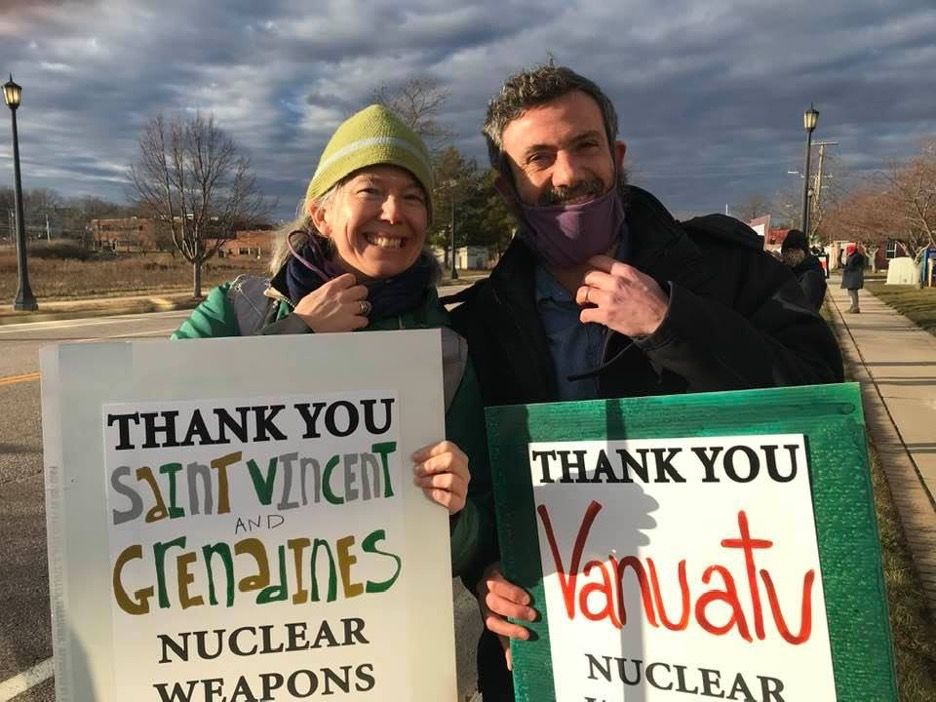
For the last few years, as I hold my sign, I sometimes chat with bright young people with degrees in mathematics and engineering. They aren’t going into jobs in the military industry. They are choosing careers in teaching or green technology. I tell them they are making the right decision. The Manhattan Project scientists who prepared the first atomic bomb test didn’t know what was going to happen—it was just that: a test. As Oppenheimer dramatizes, Enrico Fermi took bets on the world ending—a little gallows humor, but there were actually some early concerns that the atmosphere or the sea might catch on fire! Physics dispelled those particular fears, but the far more dangerous experiment of arming ourselves with nuclear weapons carries on. If we didn’t risk annihilation of the planet on July 16, 1945, we’ve continued to risk it every day since. So, by that measure, what’s a little more carbon dioxide in the atmosphere, a hole in the ozone, a calving iceberg, or a warming gulf stream? What indeed? Peril is peril, and we need to confront it all! How these young people decide to spend their time and energy matters.
I asked my students, “Do fear tactics (like my little blow-up-New London website deomonstration) work? Does fear motivate people to action in the work for nuclear disarmament? Wouldn’t hope be better?” I honestly expected they would want to run away from their fearfulness as quickly as possible. I wasn’t just asking as their teacher. I was asking as someone old enough to be their parent, who grew up terrified of nuclear weapons and was taught that the only way to allay those fears was by nuclear disarmament. One of my students, who is often quiet and often late, raised his hand. “I think that you have to be afraid first, and that helps you care. And then once you care, you can focus on working for what you hope will happen, or whatever… Does that make sense?”
Yes, yes, it does. My student might have nodded off after that jolt of brilliance, but I was both validated and motivated by what he said. I worry about them—not just because of nuclear weapons or climate change or societal collapse—but because in the last dozen or so weeks of labor, I have come to care for each of them. I’m paid as an adjunct (which means barely), but I pull many hours preparing classes for them each week. For this focus on nuclear weapons, I went down multiple internet rabbit holes. I revisited the Hiroshima footage I watched as a child: grainy black and white deathscapes and doctors ministering to people with terrible burns. I reviewed TED Talks and Democracy Now! interviews with experts on nuclear weapons. I thought about showing them Amazing Grace and Chuck, a 1980s drama I loved as a kid (it doesn’t hold up well) about a Little League pitcher who refuses to play ball unless the United States and USSR agree to disarm.
In the end, I dressed up like Robert Oppenheimer (it was Halloween), dropped the Bomb on them, and shared a simple video watched over and over again as I prepared for class.[12] It was so hopeful and different from anything else I considered: You see a set of hands, naming all the components of a nuclear missile made of clay; the hands then take the missile apart and destroy the parts. Here in my town (the real one, not the one I reduced to rubble), the newspapers write about “critical material” and “submarine industrial base production rates” and “force augmentation.” Nuclear weapons are discussed with almost liturgical dispassion, their power and their madness are shrouded in jargon and techno-speech. That does not help! In this visual aid there is no jargon, no politics, no posturing, no explaining. Just a pair of hands against a turquoise background, dismantling nuclear weapons.

That work isn’t just happening on the internet. Real nuclear weapons have been unmade. We have done it, I told the students. It is happening at the international negotiating table, in the council chambers, in the streets. As the Cold War came to an end, the Nunn-Lugar Cooperative Threat Reduction Agreement deactivated 7,527 real strategic nuclear warheads and destroyed 774 real intercontinental ballistic missiles, 651 real submarine launched ballistic missiles, and 906 real nuclear air-to-surface missiles.
And it is not just in the past. Halfway through the class I changed outfits, trading my Oppenheimer fedora for a hard hat and my suit jacket and tie for a safety vest emblazoned with “Citizen Weapons Dismantler.” I explained that we were empowered by the Treaty on the Prohibition of Nuclear Weapons, which entered into force in 2021 and is now binding international law; only the nine nuclear weapons states and their clients stand outside of the growing global consensus on disarmament. I explained that every major arms control treaty and step towards disarmament made by nations bilaterally or at the United Nations level was demanded and prodded forward by broad-based organizing at the grassroots level—in streets and town squares all over the world. The TPNW just put that grassroots work first.
And I explained that we could start taking the weapons apart. Article 4, paragraph 2 of the Treaty deals with the dismantlement of nuclear warheads to bring the nuclear weapons states into compliance. The steps are clearly explained as (1) “each State Party that owns, possesses or controls nuclear weapons or other nuclear explosive devices shall immediately remove them from operational status,” and then (2) “destroy them as soon as possible but not later than a deadline to be determined by the first meeting of States Parties.”[13] It is as simple as that.
They laughed at my antics, and kept listening. “The United States will have to join it at some point!” We were envisioning that future together. And for a few beautiful minutes, it felt like the 19 of us were making it happen.
Acknowledgments
Peter Ferenbach of ReThink Media was extremely helpful in framing this piece. Thanks also to my mentor William D. Hartung, and to Joanne Sheehan, New England organizer with the War Resisters League (and my mother-in-law).
Endnotes
[1] See Nukemap at https://nuclearsecrecy.com/nukemap/
[2] See “Experience the power of a low-yield nuclear weapon in your area,” by Outrider, at https://outrider.org/nuclear-weapons/interactive/bomb-blast
[3] See “ Majority of Americans Want to Learn More about Nuclear Weapons,” Carnegie Corporation of New York, at https://www.carnegie.org/news/articles/majority-americans-want-learn-more-about-nuclear-weapons/
[4] See “ Majority of Americans Want to Learn More about Nuclear Weapons,” Carnegie Corporation of New York, at https://www.carnegie.org/publications/majority-us-interested-boosting-their-nuclear-knowledge/
[5] See “Majority in the U.S. Interested in Boosting Their Nuclear Knowledge,” U.S. Government Accountability Office https://www.gao.gov/products/gao-23-106292
[6] See “Majority in the U.S. Interested in Boosting Their Nuclear Knowledge,” Center for Arms Control and Non-Proliferation https://armscontrolcenter.org/fact-sheet-u-s-nuclear-weapons-modernization-costs-constraints/
[7] See “A Not-So-Strategic Posture Commission,” Center for Arms Control and Non-Proliferationhttps://www.armscontrol.org/act/2023-11/features/not-strategic-posture-commission
[8] See “Nuclear Notebook: Nuclear Arsenals of the World,” Bulletin of the Atomic Scientists https://thebulletin.org/nuclear-notebook/
[9] See “Google Trends” https://trends.google.com/trends/explore?date=2017-06-01%202022-06-01&geo=US&q=%22nuclear%20war%22
[10] See “Google Trends” https://trends.google.com/trends/explore?geo=US&q=%22nuclear%20war%22
[11] See “The March to End Fossil Fuels,” on Democracy Now! Youtube site at https://youtu.be/_ouZUrSfGQo?feature=shared&t=106
[12] See “How to Dismantle a Nuclear Bomb” on Outrider Foundation Youtube site at https://www.youtube.com/watch?v=t_PXorv5pB4
[13] See the full text of the Treaty at https://treaties.un.org/doc/Treaties/2017/07/20170707%2003-42%20PM/Ch_XXVI_9.pdf
Together, we make the world safer.
The Bulletin elevates expert voices above the noise. But as an independent nonprofit organization, our operations depend on the support of readers like you. Help us continue to deliver quality journalism that holds leaders accountable. Your support of our work at any level is important. In return, we promise our coverage will be understandable, influential, vigilant, solution-oriented, and fair-minded. Together we can make a difference.
Keywords: activism, anti-nuclear movement, climate change, education, generation z, nuclear weapons
Topics: Nuclear Weapons, Special Topics




